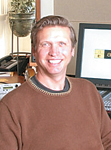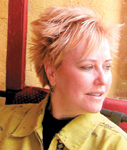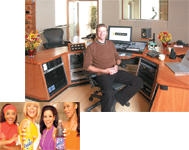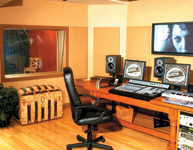Post: What's the market for 5.1 surround mixing today? Who's doing it and why?

Rex Recker, Co-Owner/Post Production Mixer AudioEngine , New York City, www.audioengine.net
|
Rex Recker: "For me the big market is cinema commercials; advertisers have chosen to use the theatrical format as a way to target their brands. We did a fantastic cinema spot for Fanta Orange Soda from Ogilvy & Mather/NY, which premiered in theaters and utilized big pictures and big sound to create an experience for the audience. I'll bet that most people sitting in the theater felt they'd been treated to a special experience, not just another commercial."

Drew Weir, Owner/Sound Designer/Engineer, Vagabond Audio, Chicago, www.vagabondaudio.com
|
Drew Weir: "We just opened in May, and we mainly do post audio for TV commercials. We see that market using 5.1 for cinema-release versions of commercials and for DVD packages of commercials for clients. We also see the ad market becoming more and more aware of HD and 5.1. But what I'm excited about right now is Dolby Pro Logic II, which is reverse compatible to standard Dolby Surround Sound. It has the same sound field as 5.1, including discrete rear channels, but no separate subwoofer. The key thing is that it can be broadcast like normal stereo audio. I see it happening for commercials to bridge the gap between 5.1 and stereo, and would like to see a [Digidesign] Pro Tools plug-in for encoding it."

Lindsay Tomasic, Studio Manager, Firehouse Recording Studios Pasadena, CA, www.firehouserecordingstudios.com
|
Lindsay Tomasic: "The market is pretty vast for us - everything from big jazz artists like Herbie Hancock and Foreplay, who occasionally want surround mixes, to the 5 Alarm Music production music library, and TV and film composers. But it's mostly been associated with HD or film projects for cinema distribution."

Tom Fleischman, Rerecording Mixer Soundtrack F/T, New York City, www.soundtrackny.com
|
Tom Fleischman: "My market is feature films. Virtually all feature films are mixed 5.1, and both of the film stages at Soundtrack F/T are set up for the 5.1 format. Five-point-one digital has been the standard format for theatrical releases for a decade. There is also a DVD market for documentaries, sports and concert films in addition to features - anything with complex tracks that would lend itself to a 5.1 mix."

Troy Krueger, Sound Designer/Mixer, Creative Group, New York City, http://post.creativegroup.tv
|
Troy Krueger: "Five-point-one is still in its infancy, but it's coming of age with some progressive clients. Often, the broadcast networks start with corporate applications like a 5.1 mix I did for a 180-degree HD presentation screen in the NBC merchandising store at Rockefeller Center. New kids on the block, like the Scream HD cable network Creative Group is launching this month, get right off the block with surround. We're mixing promos for Scream in surround and some of its original programming will be surround too."
Bobby Owsinski: "For us the market is primarily music DVDs, like concerts or HBO specials sent to us by the strategic marketing arms of the major record labels, some indie record label and film projects, the occasional theatrical release and, lately, a lot of anime projects. I've been told by a number of high-ranking record-label executives that 5.1 is a feature that helps them sell DVDs. Everyone expects it now."
Post: Do clients for 5.1 surround mixes typically want stereo mixes as well? What are the differences, technically and creatively, in performing surround and stereo mixes?
Recker: "Yes, you really have to deliver stereo mixes as well. Our room is built for cinema-style 5.1 mixing and it translates really well to broadcast 5.1 mixes; it's configured so any time we do a 5.1 mix it's automatically mixed down to two-track stereo. When everyone is happy with the 5.1 mix we listen to the stereo mix on a TV; 90 percent of the work will have been done and we'll just need to make some small adjustments. We may push anything in the surrounds forward and lower them to avoid phasing issues."

AudioEngines Rex Recker recently mixed this theatrical Fanta spot in surround.
|
Weir: "They absolutely want stereo mixes as well, and that does pose problems. How do you re-create the same excitement and energy of a 5.1 mix in stereo? It's a different animal, and I believe you have to approach it differently, bringing down some elements, maybe eliminating others. But you don't have to start from scratch: you start with a really big palette and pare it down from there. Creatively, surround mixes offer the opportunity to make more than the voiceover stand out. A 5.1 spot can be distinguished from the previous commercial or the next one by its spectacular audio palette and not just its volume."
Tomasic: "Yes, typically we'll lay off a stereo mix of a surround project. Surround mixes have a bit more presence with ambiance sections and are a bit more spacious than stereo mixes. One technical difference is the placement of elements. There are more options where to put things in surround so your creativity is also engaged by virtue of the process."

Vagabound Audio recently opened with a 5.1 suite.
|
Fleischman: "We deliver 5.1 and Dolby Stereo mixes for all films. I monitor 5.1 while mixing and then do a Dolby Stereo pass on it, listening through a Dolby matrix, and make a second printmaster. I don't usually make major changes in the mix to accommodate that.
"Five-point-one surround is creatively more challenging and interesting for me because having five discrete full-bandwidth tracks and a subwoofer makes panning and sound placement within the theater environment a lot more accurate. The surrounds are stereo, so there's an opportunity to be creative with panning there as well. With mono surrounds and a Dolby matrix, there used to be a lot of leakage of sound from the front channels to the surrounds. We didn't have as much control over what went into the surrounds. With discrete tracks we have total control."